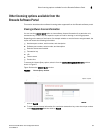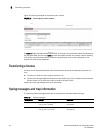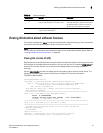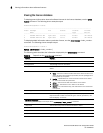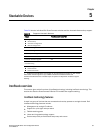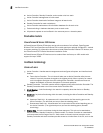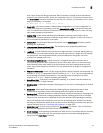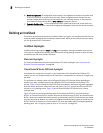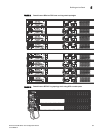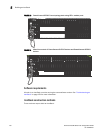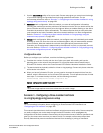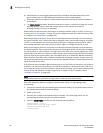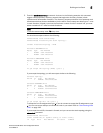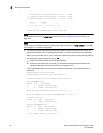
PowerConnect B-Series FCX Configuration Guide 97
53-1002266-01
IronStack overview
5
show, stack, and a few debug commands. When the stack is formed, all local consoles are
directed to the Active Controller, which can access the entire CLI. The last line of output from
the show version command indicates the role of a unit, unless it is a standalone unit, in which
case it is not shown. For example:
My stack unit ID = 1, bootup role = active
• Clean Unit - A unit that contains no startup flash configuration or run time configuration. To
erase old configuration information, enter the erase startup-config command and reset the
unit. For PowerConnect B-Series FCX devices, the run-time configuration on a clean unit may
also contain default-port information,
• Control Path - A path across stacking links dedicated to carrying control traffic such as
commands to program hardware or software image data for upgrades. A stack unit must join
the control path to operate fully in the stack.
• Default Port - PowerConnect B-Series FCX devices use the default-port command to define
stacking port candidates.
• Interprocessor Communications (IPC) - The process by which proprietary packets are
exchanged between stack unit CPUs.
• IronStack - A set of stackable units (maximum of eight) and their connected stacking links so
that: all units can be accessed through their common connections, a single unit can manage
the entire stack, and configurable entities, such as VLANs and trunk groups, can have
members on multiple stack units.
• Non-Functioning Stack Unit - A stack unit that is recognized as a stack member, and is
communicating with the Active Controller over the Control Path, but is in a non-functioning
state. Because of this state, traffic from the non-stack ports will not be forwarded into the
stack - they will be dropped or discarded. This may be caused by an image or configuration
mismatch.
• Sequential Connection - Stack unit IDs, beginning with the Active Controller, are sequential. For
example, 1, 3, 4, 6, 7 is sequential if Active Controller is 1. 1, 7, 6, 4, 3 are non-sequential in a
linear topology, but become sequential in a ring topology when counted from the other
direction as: 1, 3, 4, 6, 7. Gaps in numbering are allowed.
• Standalone Unit - A unit that is not enabled for stacking, or an Active Controller without any
Standby Controller or stack members.
• Stacking Link - A cable that connects a stacking port on one unit to a stacking port on another
unit.
• Stack Path - A data path formed across the stacking links to determine the set of stack
members that are present in the stack topology, and their locations in the stack.
• Stacking Port - A physical interface on a stack unit that connects a stacking link. Stacking ports
are point-to-point links that exchange proprietary packets. Stacking ports must be 10 Gbps
Ethernet ports, and cannot be configured for any other purpose while operating as stacking
ports. Dell stacking units contain two ports that can be stacking ports. However, the flexible
stacking port feature also allows you to use one port as a stacking port and the other port as a
regular data port. Refer to “Controlling stack topology” on page 126.
• Stack Slot - slot in a stack is synonymous with line module in a chassis. Table 22 shows the
port and slot designations for PowerConnect stackable devices.
• Stack Topology - A contiguously-connected set of stack units in an IronStack that are currently
communicating with each other. All units that are present in the stack topology appear in
output from the show stack command.



